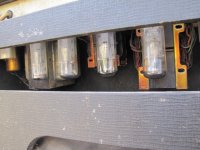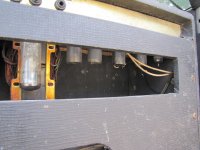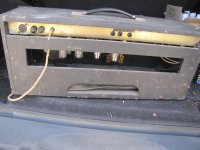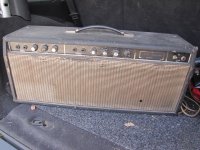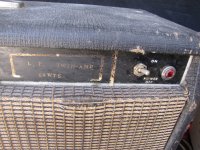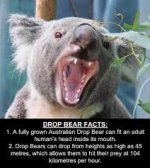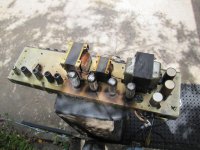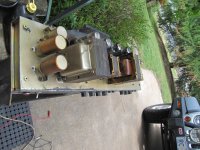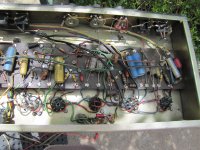Hoping someone can identify an amp I have. It is obviously a guitar/band amp that has 4 EL34 output tubes and the letters LP on the front panel. I cannot find any reference to LP amps and don't think it is Les Paul but you never know. Images attached this time.
Attachments
How is this "low power"? Four EL34 can meet or beat a quad of 6L6. The OT looks ample for two tube and not that shy for four.
The "L.P. ...." part looks crooked and yellowed, while the rest of the faceplate is well preserved.
Australia/NZ had dozens of small builders working on the margin between shipping and import taxes from NA/EUR.
This may be a "dropbear", an example of a species not seen outside Australia. 😕🙄
The "L.P. ...." part looks crooked and yellowed, while the rest of the faceplate is well preserved.
Australia/NZ had dozens of small builders working on the margin between shipping and import taxes from NA/EUR.
This may be a "dropbear", an example of a species not seen outside Australia. 😕🙄
Attachments
It doesn't look particularly like a dropbear to me - maybe a soundclip will indicate if it sounds like one. Perhaps if the OP can show some more photos, including parts under the chassis and on the chassis then that may better indicate an origin. It could also be from the other side of the ditch 🙂
Okay, it is a generic copy from a long closed workshop scale factory..
Does it work, or do you need help for it?
Does it work, or do you need help for it?
Is that a knowledgeable comment, or just meant to be a quip or guess?Okay, it is a generic copy from a long closed workshop scale factory..
The amp is identified, now what?
If you look for defunct audio makers, the lists are long.
You have a problem with using it (how to), or there is a need for repair?
Or, just bought it to do up and sell as a rare Les Paul?
That was my intention...
If you look for defunct audio makers, the lists are long.
You have a problem with using it (how to), or there is a need for repair?
Or, just bought it to do up and sell as a rare Les Paul?
That was my intention...
LP ... Twin Amp ... 60 Wts all lok yellowish crumbling but above all, hand applied, so mean NOTHING.
I used to make similar panels using hand applied Letraset rub-on letters and white tape in variousn widths, then spray varnished over.
40 y.o. varnish could look yellowed and cracked.
"Reverb" also looks hand applied and misaligned.
Transformer frames (2 out of 3) are typically British, as well as Vynide covering and Mullard EL34, so British or Australian locally made.
Forget using LP as identification, it might very well be Leonard Portnoy´s amp or some similar name.
It is NOT 60W but 100W because of visible tubes and iron, no labelling on the back (except homemade) show it´s a homemade amp.
The guts might offer more clues.
It might be one of ozvalveamps,check there, not by name but by picture.
FWIW LP Twins had TWO 6L6 and none had Reverb
Show some gut pictures, which could also show some signature, date, parts with date codes, etc.
I used to make similar panels using hand applied Letraset rub-on letters and white tape in variousn widths, then spray varnished over.
40 y.o. varnish could look yellowed and cracked.
"Reverb" also looks hand applied and misaligned.
Transformer frames (2 out of 3) are typically British, as well as Vynide covering and Mullard EL34, so British or Australian locally made.
Forget using LP as identification, it might very well be Leonard Portnoy´s amp or some similar name.
It is NOT 60W but 100W because of visible tubes and iron, no labelling on the back (except homemade) show it´s a homemade amp.
The guts might offer more clues.
It might be one of ozvalveamps,check there, not by name but by picture.
FWIW LP Twins had TWO 6L6 and none had Reverb
Show some gut pictures, which could also show some signature, date, parts with date codes, etc.
Help to Identify Amp
Thanks for all the responses. Have finally got around to pulling it out of the case and taking some pictures. Valve line up is 4 EL34, 4 ECC83, 1 ECC81. It is possible, one ECC83 has been added to replace an octal base valve. Powered it up through variac for a couple of minutes and surprisingly, it worked. No useful markings on components but most caps appear to be British made
Thanks for all the responses. Have finally got around to pulling it out of the case and taking some pictures. Valve line up is 4 EL34, 4 ECC83, 1 ECC81. It is possible, one ECC83 has been added to replace an octal base valve. Powered it up through variac for a couple of minutes and surprisingly, it worked. No useful markings on components but most caps appear to be British made
Attachments
Last edited:
I'd suggest that photos showing part markings would be needed to get a better awareness - as there is not enough resolution in those photos (unless you have those as high res photos that can be accessed via the internet).
It's still too unclear to get a good view of a range of parts. It is looking more like a UK manufactured amp, given the transformer clamps and Hunts cap. If it was from UK then a forum like UK Vintage Radio may be also worthwhile airing photos with - but I'd recommend adding close-ups of more parts.
Thanks. I could take some better pics but the only markings are on the caps and they indicate British made, so I reckon it is a British made amp. Nothing at all on the transformers to provide any clues.
The caps have date codes, and if enough are consistent then that narrows timing. The transformer frames indicate a certain manufacturer. If all the caps have british made manufacturers then that is important imho.
The transformers without bell-ends appear to be Partridge, based on the frames and clamping (eg. as used by Hiwatt, Sound city, Laney).
Hunts capacitor datecode is a three capital letter format which includes only the following letters WHITSUNDAY (and the format provides a year of decade number and a week of year number). I've never come across the e-cap with the name/label of NORMAN before.
Chassis layout is sort of like some Laney's.
Hunts capacitor datecode is a three capital letter format which includes only the following letters WHITSUNDAY (and the format provides a year of decade number and a week of year number). I've never come across the e-cap with the name/label of NORMAN before.
Chassis layout is sort of like some Laney's.
Last edited:
Interesting, would W be 0 or 1?Hunts capacitor datecode is a three capital letter format which includes only the following letters WHITSUNDAY (and the format provides a year of decade number and a week of year number).
Here teachers hide pupil´s qualifications (which go from 0 to 10), using the non repeating letters surname: BELGRANITO
Manuel Belgrano being the creator of our National Flag and Belgranito meaning "Young Belgrano", very easy to remember, specially for a teacher.
1234567890. Sometimes the year is the first or the last number, so it helps when there are lots of Hunts caps to rationalise a year of manufacture. Although finding Hunts caps in an amp is increasingly rare, especially for 1950-60's equipment, as they had such a bad reputation. That amp looks like it was put away early in its life (with respect to e-cap replacement).
- Home
- Live Sound
- Instruments and Amps
- Help to identify Amp
